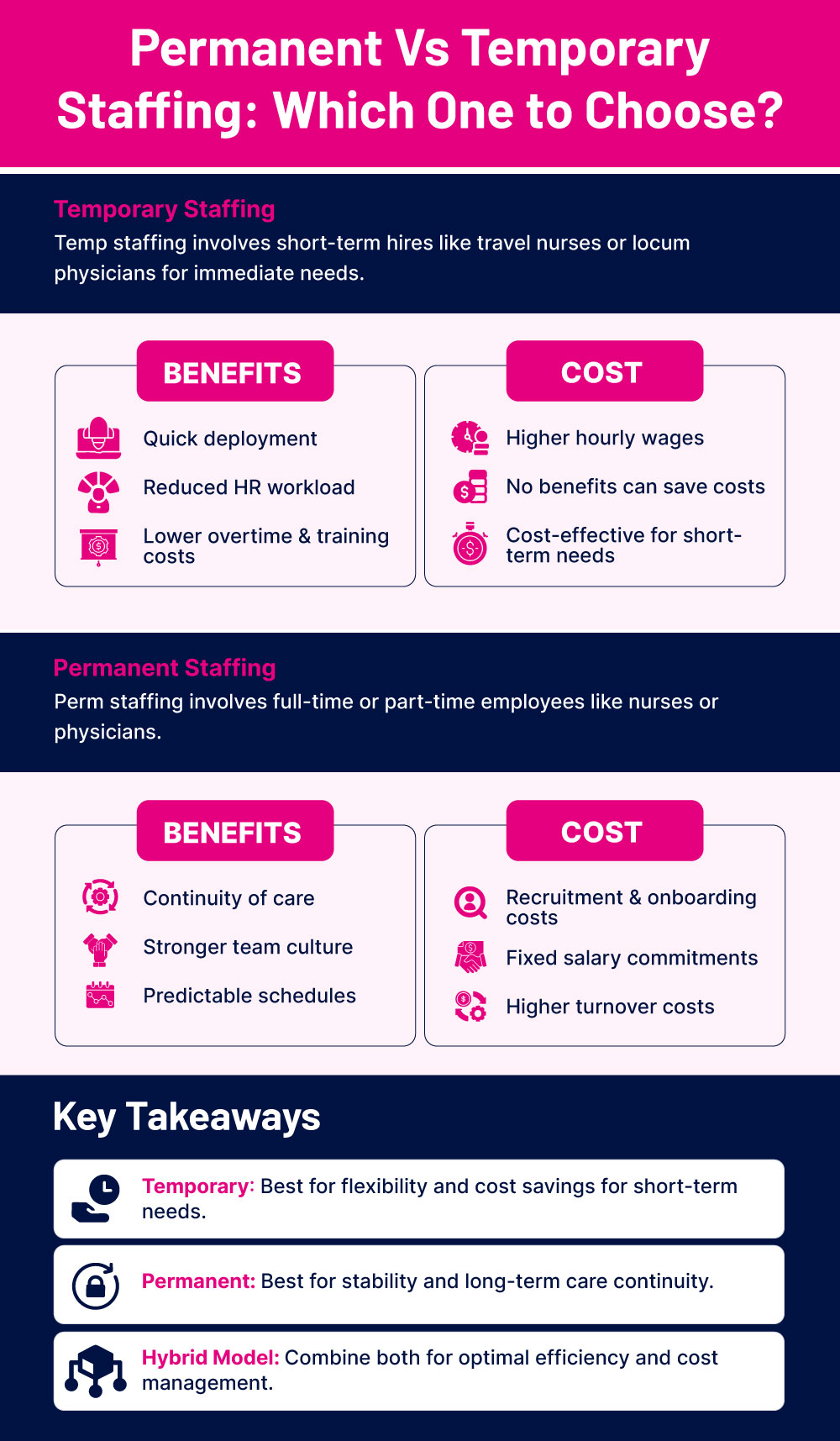Topics: Temp vs Perm Staffing, Temporary Staffing
Posted on August 11, 2025
Written By Ranjana Singh

Choosing between temporary and permanent healthcare staffing can significantly affect your firm’s costs and efficiency. With U.S. healthcare facing ongoing staffing shortages and budget pressures, hospitals and clinics must pick the right staffing model to maintain patient care without breaking the bank. The big question is: temporary vs permanent staffing – which model saves you more money?
In this blog we’ll break down:
The U.S. healthcare system is grappling with a staffing crisis currently. Hospitals nationwide are short on nurses, technicians, and other professionals. Burnout from the pandemic led many to leave the field, and aging Baby Boomers are driving up patient demand.
In fact, the U.S. Bureau of Labor Statistics projects over 275,000 additional nurses will be needed by 2030 to meet rising healthcare needs. This shortage means competition (and costs) for talent are higher than ever.
Choosing the right mix of temporary and permanent staff has become a key strategy for controlling costs while ensuring quality care.
By understanding these staffing models, healthcare leaders can make informed decisions to optimize budgets and maintain high-quality care. Let’s start by clarifying each model.

Temporary staffing involves hiring short-term healthcare professionals, such as travel nurses, locum tenens physicians, or per diem staff, to fill immediate needs. For example, a hospital might hire a travel nurse during a flu outbreak or a locum physician to cover a vacation.
Permanent staffing refers to hiring full-time or part-time employees directly into your organization. These are your core nurses, physicians, and allied health professionals, like a full-time nurse or a salaried physician.
While permanent staffing ensures long-term stability, it requires higher overhead costs like salaries and benefits. Temporary staffing, on the other hand, offers flexibility but may involve higher hourly rates and less continuity.
Temporary staff typically have higher hourly wages but offer several cost-saving benefits:
Temporary staffing is cost-effective for short-term needs but can become expensive if relied upon long-term.
Permanent employees require significant investment:
Permanent staff offer stability and continuity but require higher long-term investment. They’re most cost-effective with low turnover and proper retention strategies.
In 2025, many healthcare facilities adopt hybrid models, using a core permanent team for stability and temporary staff for flexibility during peak times. Technologies like AI-driven staffing and predictive analytics can optimize both models, ensuring efficient staffing while minimizing costs.
The ideal staffing model depends on your facility’s budget, location, patient volume, and specialty needs. A balanced approach, leveraging both permanent and temporary staff, often offers the best financial and operational outcomes.
Temporary staffing helps maintain patient care quality by preventing understaffing and burnout. While temporary staff bring experience, consistency can be an issue if relied on too heavily. Balancing temporary workers with permanent staff ensures continuity while filling gaps and upholding care standards.
Permanent staff can be cost-effective over time, particularly with low turnover. While there are initial recruitment and training costs, long-tenured employees improve efficiency, reduce hiring expenses, and contribute to better patient outcomes. High turnover can make temporary staffing more cost-effective in some cases.
Both staffing models must meet compliance standards. Permanent staff are managed by in-house HR for credentialing, while temporary staffing agencies handle pre-screening and compliance. The healthcare facility must ensure agency workers are oriented to specific policies and follow labor regulations.
QX Global Group tailors staffing solutions by understanding the specific needs of each healthcare facility. They offer dedicated teams for permanent and temporary roles, adapt to compliance and staffing urgency, and provide flexible models. Moreover, there is advanced technology that ensures efficient, data-driven solutions.
Start by contacting QX Global Group for a consultation to assess your staffing needs. QX will create a tailored proposal, onboard your organization, and begin recruiting. Our dedicated transition team makes sure you have a smooth onboarding experience, and ongoing support ensures staffing strategies evolve to meet your facility’s needs.
Choosing between temporary and permanent healthcare staffing depends on your organization’s specific needs. Temporary staffing offers flexibility and short-term cost savings but may lead to higher hourly rates and continuity challenges if overused. Permanent staffing provides stability, team cohesion, and long-term quality care but comes with higher upfront and overhead costs.
Partnering with staffing experts like QX Global Group, who provide outsourced recruitment services in US can help tailor a solution that fits your needs, streamlining recruitment and improving cost-efficiency while maintaining high-quality care.
Enjoyed our blog? Discover more about how our recruitment outsourcing process can slash your costs by up to 60%! Take the next step—book a call by entering your details.
Originally published Aug 11, 2025 11:08:46, updated Aug 29 2025
Topics: Temp vs Perm Staffing, Temporary Staffing